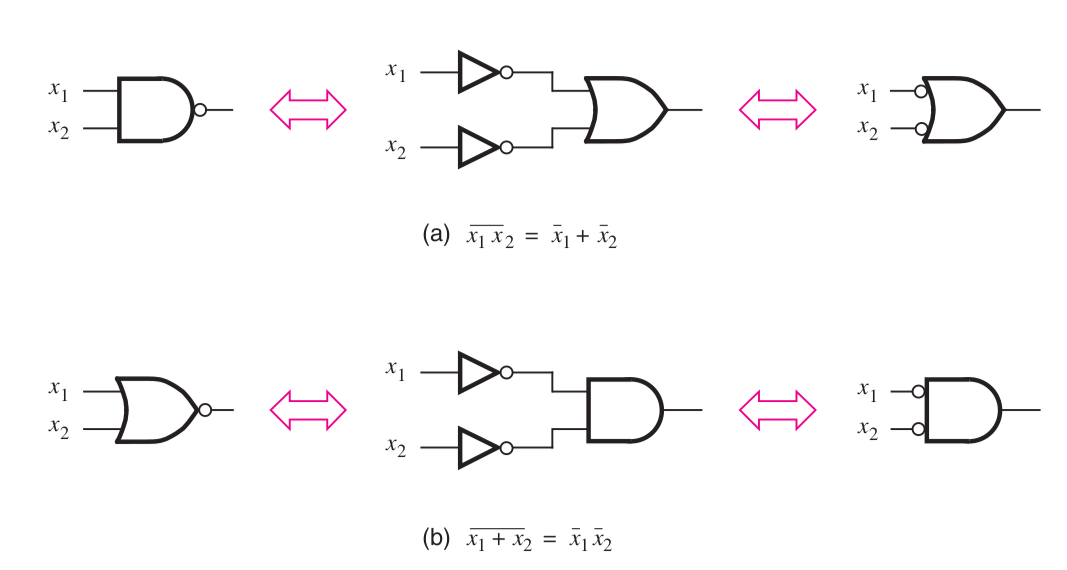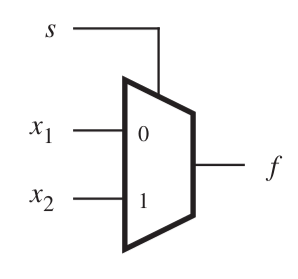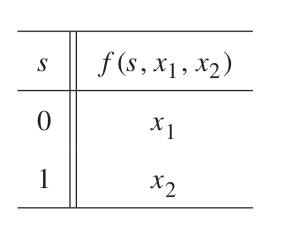ECE 275: Boolean algebra
Vikas Dhiman
https://vikasdhiman.info/ECE275-Sequential-Logic/
On the naming of Mintems
The minterms and maxterms derive their names from the fact that they are respectively the minimum and maximum areas which may be defined on a Venn diagram .
NBS Technical Note. (1959)
\( m_0 = \bar{x}_1 \bar{x}_2 \)

\( m_1 = \bar{x}_1 x_2 \)

\( m_2 = x_1 \bar{x}_2 \)

\( m_3 = x_1 x_2 \)

Truth table to K-map
| Row num | A | B | C | D | f |
|---|---|---|---|---|---|
| 0 | 0 | 0 | 0 | 0 | 0 |
| 1 | 0 | 0 | 0 | 1 | 1 |
| 2 | 0 | 0 | 1 | 0 | 0 |
| 3 | 0 | 0 | 1 | 1 | 0 |
| 4 | 0 | 1 | 0 | 0 | 0 |
| 5 | 0 | 1 | 0 | 1 | 1 |
| 6 | 0 | 1 | 1 | 0 | 0 |
| 7 | 0 | 1 | 1 | 1 | 0 |
| 8 | 1 | 0 | 0 | 0 | 0 |
| 9 | 1 | 0 | 0 | 1 | 0 |
| 10 | 1 | 0 | 1 | 0 | 0 |
| 11 | 1 | 0 | 1 | 1 | 0 |
| 12 | 1 | 1 | 0 | 0 | 0 |
| 13 | 1 | 1 | 0 | 1 | 1 |
| 14 | 1 | 1 | 1 | 0 | 0 |
| 15 | 1 | 1 | 1 | 1 | 0 |
K-map
| \(\bar{A}\) | \(A \) | ||||
|---|---|---|---|---|---|
| \(\bar{B}\) | \(B \) | \(\bar{B}\) | |||
| \(\bar{C}\) | \(\bar{D}\) | \(m_0\) | \(m_4\) | \(m_{12}\) | \(m_8\) |
| \(D\) | \(m_1\) | \(m_5\) | \(m_{13}\) | \(m_9\) | |
| \(C\) | \(m_3\) | \(m_7\) | \(m_{15}\) | \(m_{11}\) | |
| \(\bar{D}\) | \(m_2\) | \(m_6\) | \(m_{14}\) | \(m_{10}\) | |
| \(\bar{A}\) | \(A \) | ||||
|---|---|---|---|---|---|
| \(\bar{B}\) | \(B \) | \(\bar{B}\) | |||
| \(\bar{C}\) | \(\bar{D}\) | 0 | 0 | 0 | 0 |
| \(D\) | 1 | 1 | 1 | 0 | |
| \(C\) | 0 | 0 | 0 | 0 | |
| \(\bar{D}\) | 0 | 0 | 0 | 0 | |
K-map to expression
K-map
| \(\bar{A}\) | \(A \) | ||||
|---|---|---|---|---|---|
| \(\bar{B}\) | \(B \) | \(\bar{B}\) | |||
| \(\bar{C}\) | \(\bar{D}\) | 0 | 0 | 0 | 0 |
| \(D\) | 1 | 1 | 1 | 0 | |
| \(C\) | 0 | 0 | 0 | 0 | |
| \(\bar{D}\) | 0 | 0 | 0 | 0 | |
Expression
\(f = \bar{A}\bar{C}D + B\bar{C}D \)
Expression to truth table
Expression
\(f = \bar{A}\bar{C}D + B\bar{C}D \)Truth table
| Row num | A | B | C | D | \(\bar{A}\bar{C}D\) | \(B\bar{C}D\) | f |
|---|---|---|---|---|---|---|---|
| 0 | 0 | 0 | 0 | 0 | 0 | 0 | 0 |
| 1 | 0 | 0 | 0 | 1 | 1 | 0 | 1 |
| 2 | 0 | 0 | 1 | 0 | 0 | 0 | 0 |
| 3 | 0 | 0 | 1 | 1 | 0 | 0 | 0 |
| 4 | 0 | 1 | 0 | 0 | 0 | 0 | 0 |
| 5 | 0 | 1 | 0 | 1 | 1 | 1 | 1 |
| 6 | 0 | 1 | 1 | 0 | 0 | 0 | 0 |
| 7 | 0 | 1 | 1 | 1 | 0 | 0 | 0 |
| 8 | 1 | 0 | 0 | 0 | 0 | 0 | 0 |
| 9 | 1 | 0 | 0 | 1 | 0 | 0 | 0 |
| 10 | 1 | 0 | 1 | 0 | 0 | 0 | 0 |
| 11 | 1 | 0 | 1 | 1 | 0 | 0 | 0 |
| 12 | 1 | 1 | 0 | 0 | 0 | 0 | 0 |
| 13 | 1 | 1 | 0 | 1 | 0 | 1 | 1 |
| 14 | 1 | 1 | 1 | 0 | 0 | 0 | 0 |
| 15 | 1 | 1 | 1 | 1 | 0 | 0 | 0 |
Truth table to timing diagram
| Row num | 0 | 1 | 2 | 3 | 4 | 5 | 6 | 7 | 8 | 9 | 10 | 11 | 12 | 13 | 14 | 15 |
|---|---|---|---|---|---|---|---|---|---|---|---|---|---|---|---|---|
| A | 0 | 0 | 0 | 0 | 0 | 0 | 0 | 0 | 1 | 1 | 1 | 1 | 1 | 1 | 1 | 1 |
| B | 0 | 0 | 0 | 0 | 1 | 1 | 1 | 1 | 0 | 0 | 0 | 0 | 1 | 1 | 1 | 1 |
| C | 0 | 0 | 1 | 1 | 0 | 0 | 1 | 1 | 0 | 0 | 1 | 1 | 0 | 0 | 1 | 1 |
| D | 0 | 1 | 0 | 1 | 0 | 1 | 0 | 1 | 0 | 1 | 0 | 1 | 0 | 1 | 0 | 1 |
| f | 0 | 1 | 0 | 0 | 0 | 1 | 0 | 0 | 0 | 0 | 0 | 0 | 0 | 1 | 0 | 0 |
Boolean expression to Verilog
\( f = \overline{(A\bar{B} + C)}D \)Verilog
module examplefunction1(A, B, C, D, f);
input A, B, C, D;
output f;
assign f = (~(A&(~B) | C))&D;
endmodule
Functionally equiv networks
\(f_2 = (\bar{A} + B)\bar{C}D \)
Boolean algebra
Axioms
- \( 0 \cdot 0 = 0 \)
- \( 1 + 1 = 1 \)
- \( 1 \cdot 1 = 1 \)
- \( 0 + 0 = 0 \)
- \( 0 \cdot 1 = 1 \cdot 0 = 0 \)
- \( \bar{0} = 1 \)
- \( \bar{1} = 0 \)
Single variable Theorems
- \( x \cdot 0 = 0 \)
- \( x + 1 = 1 \)
- \( x \cdot 1 = x \)
- \( x + 0 = x \)
- \( x \cdot x = x \)
- \( x + x = x \)
-
\( x \cdot \bar{x} = 0 \)
\( x + \bar{x} = 1 \) - \(\bar{\bar{x}} = x \)
Duality: Swap \( + \) with \( \cdot \) and \( 0 \) with \( 1 \) to get another law
Two and three variable properties
| \(x \cdot y = y \cdot x\) | Commutative |
| \(x + y = y + x\) | |
| \(x \cdot (y \cdot z) = (x \cdot y) \cdot z\) | Associative |
| \(x + (y + z)= (x + y) + z\) | |
| \(x \cdot (y + z) = x\cdot y + x \cdot z\) | Distributive |
| \(x + y\cdot z = (x+y) \cdot (x+z)\) |
DeMorgan's theorem
- \( \overline{x \cdot y} = \bar{x} + \bar{y} \)
- \( \overline{x + y} = \bar{x} \cdot \bar{y} \)
DeMorgan's theorem
- \( \overline{x \cdot y} = \bar{x} + \bar{y} \)
- \( \overline{x + y} = \bar{x} \cdot \bar{y} \)

Prove that for two variable function
\( \bar{m}_0 = M_0 \)Soln: Prove that for two variable function
\( \bar{m}_0 = M_0 \) \begin{align} m_0 &= \bar{x}_1 \bar{x}_2 & \text{ by definition of } m_0 \\ \implies \bar{m}_0 &= \overline{\bar{x}_1 \bar{x}_2} & \\ &= \bar{\bar{x}}_1 + \bar{\bar{x}}_2 & \text{ by DeMorgan's theorem } \\ &= x_1 + x_2 = M_0 & \text{ by definition of } M_0 \end{align}Inequality
- Define \(x \le y \) as \(x = 0\) whenever \( y = 0 \)
- If \(x \le y \) and \( y \le x\), then \( x = y \)
- If \(x \le y \), then \( x \cdot y = x \) and \(x + y = y\)
- \(x \cdot z \le z \) and \( x \cdot z \le x\)
Two and three variable properties
| \(x + x \cdot y = x \) | Absorption |
| \(x \cdot (x + y) = x \) | |
| \(x \cdot y + x \cdot \bar{y} = x \) | Combining |
| \((x + y)\cdot (x + \bar{y}) = x \) |
Two and three variable properties
| \(x + \bar{x}y = x + y \) | Concensus |
| \(x \cdot (\bar{x} + y) = x \cdot y \) | |
| \(x \cdot y + y \cdot z + \bar{x} \cdot z = x \cdot y + \bar{x} \cdot z \) | |
| \((x + y) \cdot ( y + z ) \cdot (\bar{x} + z) = (x + y) \cdot (\bar{x} + z) \) |
\[
\newcommand{\bx}{\bar{x}}
\newcommand{\by}{\bar{y}}
\newcommand{\bz}{\bar{z}}
\]
Prove that
If \( x + y = 1 \) and \( xy = 0 \) then \( \bx = y \)Soln: Prove that
If \( x + y = 1 \) and \( xy = 0 \) then \( \bx = y \)
\begin{align}
&x + y = 1
\\
&\implies x \bx + y \bx = \bx & \text{ multiply both sides by } \bx
\\
&\implies y \bx = \bx & \because x \bx = 0
\\
&\implies y \bx + y x = \bx + y x & \text{ add } y x \text{ to both sides }
\\
&\implies y (\bx + x) = \bx & \text{by dist. prop. and } xy = y x = 0
\\
&\implies y = \bx &
\end{align}
Prove that for two variable function
\( \overline{\sum m(0, 2)} = \sum m(1, 3) \)Soln: Prove that for two variable function
\( \overline{\sum m(0, 2)} = \sum m(1, 3) \)
We know that \( \sum m(0, 2) + \sum m(1, 3) = 1 \)
\begin{align} \left(\sum m(0, 2) \right)& \cdot \left(\sum m(1, 3) \right)\\ &= (\bx_1 \bx_2 + x_1 \bx_2)(\bx_1 x_2 + x_1 x_2) \\ &= \bx_1 \bx_2 \bx_1 x_2 + \bx_1 \bx_2 x_1 x_2 + x_1 \bx_2 \bx_1 x_2 + x_1 \bx_2 x_1 x_2 \\ &= 0 \end{align}
We know that \( \sum m(0, 2) + \sum m(1, 3) = 1 \)
\begin{align} \left(\sum m(0, 2) \right)& \cdot \left(\sum m(1, 3) \right)\\ &= (\bx_1 \bx_2 + x_1 \bx_2)(\bx_1 x_2 + x_1 x_2) \\ &= \bx_1 \bx_2 \bx_1 x_2 + \bx_1 \bx_2 x_1 x_2 + x_1 \bx_2 \bx_1 x_2 + x_1 \bx_2 x_1 x_2 \\ &= 0 \end{align}
Prove that for three variable function
\( \sum m(0, 2, 3, 7) = \prod M(1, 4, 5, 6) \)Soln: Prove that for three variable function
\begin{align} \sum m(0, 2, 3, 7) &= m_0 + m_2 + m_3 + m_7 \\ &= \overline{ m_1 + m_4 + m_5 + m_6} \\ &= \bar{m}_1 \bar{m}_4 \bar{m}_5 \bar{m}_6 \\ &= M_1 M_4 M_5 M_6 \\ &=\prod M(1, 4, 5, 6) \end{align}Design of three-way light control
Soln: three-way light control
Truth table
| Row | x | y | z | f |
|---|---|---|---|---|
| 0 | 0 | 0 | 0 | 0 |
| 1 | 0 | 0 | 1 | 1 |
| 2 | 0 | 1 | 0 | 1 |
| 3 | 0 | 1 | 1 | 0 |
| 4 | 1 | 0 | 0 | 1 |
| 5 | 1 | 0 | 1 | 0 |
| 6 | 1 | 1 | 0 | 0 |
| 7 | 1 | 1 | 1 | 1 |
\[ f = \sum m (1, 2, 4, 7)
\\= \bar{x} \bar{y} z + \bar{x} y \bar{z} + x \bar{y} \bar{z} + xyz \]
| \(\bar{x}\) | \(x \) | |||
|---|---|---|---|---|
| \(\bar{y}\) | \(y \) | \(\bar{y}\) | ||
| \(\bar{z}\) | 0 | 1 | 0 | 1 |
| \(z\) | 1 | 0 | 1 | 0 |
Design a multiplexer


Soln: multiplexer
| Row | s | x_1 | x_2 | f |
|---|---|---|---|---|
| 0 | 0 | 0 | 0 | 0 |
| 1 | 0 | 0 | 1 | 0 |
| 2 | 0 | 1 | 0 | 1 |
| 3 | 0 | 1 | 1 | 1 |
| 4 | 1 | 0 | 0 | 0 |
| 5 | 1 | 0 | 1 | 1 |
| 6 | 1 | 1 | 0 | 0 |
| 7 | 1 | 1 | 1 | 1 |
\( f = \sum m(2, 3, 5, 7) \)
| \(\bar{s}\) | \(s \) | |||
|---|---|---|---|---|
| \(\bar{x_1}\) | \(x_1 \) | \(\bar{x_1}\) | ||
| \(\bar{x_2}\) | 0 | 1 | 0 | 0 |
| \(x_2\) | 0 | 1 | 1 | 1 |
\(f = sx_1 + \bar{s} x_2 \)
Thanks, Questions, Feedback?
https://vikasdhiman.info/ECE275-Sequential-Logic/